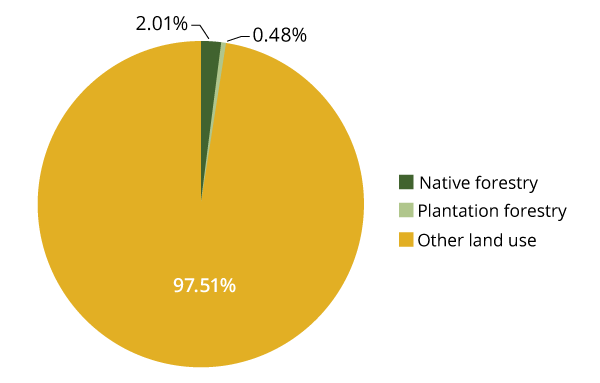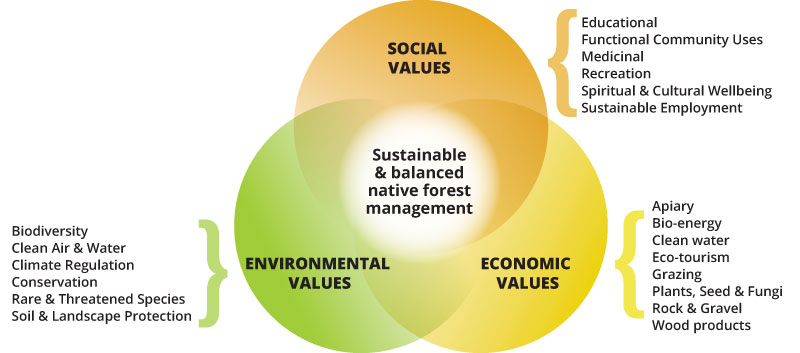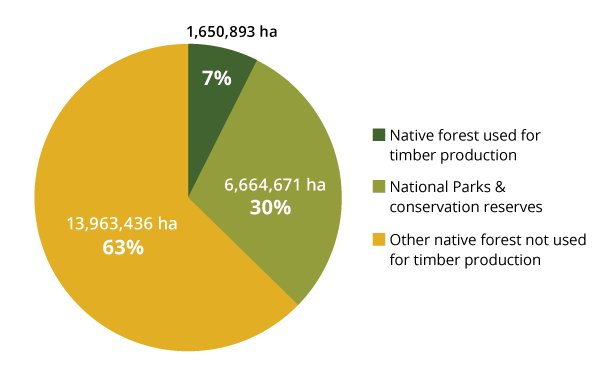Timber: A Renewable Resource
For millennia, timber has been prized as a renewable, recyclable natural resource that is beautiful, versatile and characteristic of the land that produces it.
New South Wales boasts a diverse array of native and plantation forests that have produced remarkable timbers for generations past and will supply many generations to come.
Timber is not only a renewable and recyclable resource, but it is energy-efficient to produce. Importantly, timber acts as a carbon store, giving it an important role to play in reducing carbon emissions.
When sustainably produced, timber offers multiple ‘values’ to New South Wales: environmental, social and economic.
Producing timber in a sustainable way requires long-term planning. We outline below the Regional Forest Agreements and the NSW Forest Agreements that help provide certainty for forest-based industries, forest-dependent communities and conservation.
The forestry activities carried out on New South Wales forests and private lands are strictly governed by laws, standards and conditions agreed by State and Federal governments.
In fact, forests in New South Wales are some of the most heavily protected in the world. Below, we look at the laws and protections in place, as well as at forest and chain of custody certification.
Environmental Credentials
Renewable
Timber production is a renewable land-use that is undertaken in forestry plantations and natural multiple-use forests across New South Wales.
Managing forests for timber is a cyclical process that involves the harvest and regeneration of forests on a continuing basis. Every time a tree is harvested up to ten trees are re-established in its place. As the trees regrow they seek more light and space and natural competition gives rise to some trees becoming dominant over overs.
Thinning, be it natural or mechanical, provides space for growing trees and plays an important role in maintaining forest health. By the time a forest reaches maturity only a small percentage of the original trees will have survived. When some or all of these trees are harvested and the renewable cycle begins again.
Climate friendly
The world’s climate and its forests are intrinsically linked. Forests are an important component of the global carbon cycle, playing multiple roles in addressing climate change. New South Wales’ production forests and wood product industries contribute to long term carbon emissions abatement in numerous ways, including:
- capturing and storing atmospheric carbon in growing forests
- protecting forest carbon stores from damaging wildfires
- providing long-term storage of carbon in durable wood products
- providing a renewable substitute for much more emissions-intensive building materials, such as steel, aluminium and concrete
- replacing carbon-intensive fossil fuel sources such as coal, oil and gas with bioenergy from wood waste and forest thinnings and harvesting residues.
Many timber products also undergo a significant phase of recycling, further extending the carbon storage.
Multiple Values
Forests that produce wood also produce many other benefits. Wood-producing native forests are specifically managed for a multitude of other benefits (refer Figure 1)
Figure 1 – Values arising from multiple use native forests
Energy Efficient
The energy consumed in producing timber (known as embodied energy) is very low when compared to other materials that society consumes.
It generally requires around 19 times more energy to make a product from steel rather than kiln-dried hardwood; 45 times more to make a plastic product; and 85 times more energy to make a comparable aluminium product.
Recyclable
Being a natural product, timber is inherently versatile and can be readily reused and recycled into a variety of applications. Native timbers are particularly well suited to recycling because of their inherent durability, strength and character.
Recycled timber sourced from wool stores, deconstructed bridges, warehouses and railway lines all fetch premium prices in the market.
Softwood timber and paper products are less durable but equally versatile. Today’s softwood timber house frames are tomorrow’s kitchen cupboards and today’s magazines are tomorrow’s cardboard boxes.
Sustainable
The sustainability of our forests is of interest to us all, but it is of particular concern for the timber and forest products industry and those it employs. As a form of land-use, forestry has a very small footprint, occupying only 2.5%1 of the State’s land mass (refer Figure 2).
Figure 2 – Percentage of NSW land used to produce timber
 New South Wales has over 22 million hectares2 of land that supports native forests. These forests are all protected under New South Wales law.
New South Wales has over 22 million hectares2 of land that supports native forests. These forests are all protected under New South Wales law.
Only seven per cent3 of these forests are designated for timber production while 30 per cent have been set aside in national parks and conservation reserves. No commercial timber production is permitted in national parks or conservation reserves (refer Figure 3).
Figure 3 – NSW native forests land-use
Forest Agreements – Long Term Industry Planning
Regional Forest Agreements (Federal & State)
Regional Forest Agreements (RFAs) are 20-year plans for the conservation and sustainable management of Australia’s native forests.
They are one of the principal means of implementing the National Forest Policy Statement of 1992, under which the Commonwealth and all state and territory governments agreed to work towards a shared vision for Australia’s forests.
RFAs have been in operation for around 15 years. They seek a reasonable balance between conserving Australia’s forest estate and its enduring use for economic production and recreation.
They try to balance the full range of environmental, social, economic and heritage values that forests can provide for current and future generations and provide certainty for forest-based industries, forest-dependent communities and conservation.
NSW Forest Agreements & the Role of the NSW Forestry Corporation
NSW Forest Agreements are also in place for 20 years and are the result of consultation and consensus established between the NSW Government and major forest stakeholders.
By detailing the agreed basis for long-term decisions on forest use and management, they provide certainty for industry, conservation and the community and deliver on the government’s forest policy.
The national standard for forest conservation is to protect 15 per cent of each forest ecosystem. For most NSW ecosystems this target has been significantly exceeded.
The NSW Forestry Corporation manages some of the most diverse forests in Australia, growing and harvesting timber for benefit of the state. It is responsible for ensuring an ongoing supply of timber from publicly owned State forests, while also protecting other forest values.
NSW State forests cover over two million hectares of native and plantation land (refer Figure 4). Around one half of all native State forests are permanently set aside for biodiversity conservation and other values such as clean air and water and public access for recreation.
Managing a State forest requires extensive planning and assessment of all activities. The NSW Forestry Corporation has developed and implemented Ecologically Sustainable Forest Management (ESFM) plans for all of its forestry regions.
ESFM plans seek to conserve the forests, protect unique flora and fauna species and their habitats and to ensure the continued supply of timber and other forest products.
Industry Regulation
The forest areas we have today exist because they are specifically reserved for timber and other purposes. In fact, forests in New South Wales are some of the most heavily protected in the world.
The forestry activities carried out on State forests and private lands are strictly governed by laws, standards and conditions agreed by State and Federal governments.
Integrated Forest Operations Approval (IFOA’s)
Authorisation for forestry activities on public lands is given as an Integrated Forest Operations Approval (IFOA), which is regulated by the NSW Environment Protection Authority (EPA).
There are five IFOAs which geographically cover the State’s timber production areas. Four occur along the coast and one covers the west. Each coastal IFOA contains over 2000 operating conditions.
In early 2014 the NSW EPA released a discussion paper on the Remake of the coastal IFOAs with a view to reducing the costs associated with implementation and compliance and to also improve their enforceability.
NSW Forestry Corporation Codes of Practice
The NSW Forestry Corporation internally regulates its activities through Codes of Practice, which specify best management practice conditions for timber harvesting in plantations, native forests, plantation establishment and maintenance of forest roads and fire trails.
The Forest Practices Code Part 1 – Timber Harvesting in Forestry Corporation Plantations (2005) regulates harvesting operations throughout NSW Forestry Corporation softwood and hardwood plantations in New South Wales. It also provides information on good plantation management.
The provisions of the Code are binding on all parties involved in the organisation, management and practice of obtaining timber products from NSW Forestry Corporation plantations.
Private Native Forestry
Private native forestry is regulated under the Native Vegetation Act 2003 and Private Native Forestry Codes, which are regulated and administered by the EPA. The Act requires approval for any harvesting of native forests, through the development of a property vegetation plan (PVP).
By comparison, the management and timber harvesting of planted forests is less regulated. Plantations are regulated by the Plantation and Reafforestation Act 1999 and the Plantation and Reafforestation (Code) Regulation 2001.
The Act aims to promote plantation establishment and contains standards for the establishment, management and harvesting of the trees. This applies to private and government-owned plantations.
Certification
Forest Certification
In Australia, along with many other countries, a detailed legal, institutional and economic framework has been established to ensure the conservation and sustainable management of forests, one that is supported by internationally recognised systems of forest management certification.
Forest certification is a voluntary, independent assessment of sustainable forest management activities. It shows that a forest estate has been managed in an environmentally sustainable way based on agreed standards.
Forest certification schemes generally require that forest management practices conform to standards much stricter than those required by government regulation. There has been rapid growth in forest certification as a means of verifying the quality of forest management and maintaining access to markets.
The two forest management schemes operating in Australia are:
- The Australian Forest Certification Scheme (AFCS) (accredited by the international Program for Endorsement of Forest Certification Scheme (PEFC))
- Forest Stewardship Council (FSC).
Chain of Custody Certification
Chain of Custody certification is a process to trace wood up the supply chain through careful inventory and stock control.
The timber is tracked rom the certified forest where the wood was harvested through the manufacturing process and the final point of sale, whether in Australia or overseas.
Each company in the supply chain needs to be independently certified to ensure the link in the chain of custody is not broken.
1. ABARES (2013) Australia’s State of the Forests Report 2013 Five-yearly report.
2. Ibid.
3. Forestry Corporation of NSW (2013) Sustainability report supplement. OEH (2014) NSW Report on Native Vegetation 2011–13


